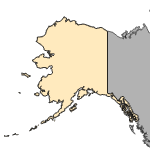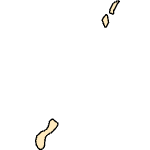Crenichthys baileyi grandis
(Hiko White River springfish)
Fishes
Native Transplant |
|
Common name: Hiko White River springfish
Taxonomy: available through
www.itis.gov
Identification: La Rivers (1962); Sigler and Sigler (1987); Page and Burr (1991). This species consists of five subspecies: C. b. albivallis, C. b. baileyi, C. b. grandis. C. b. moapae, and C. b. thermophilus.
Size: 9 cm.
Native Range: Springs and remnants of the White River system in eastern Nevada (Page and Burr 1991).



|

Alaska |

Hawaii |

Puerto Rico &
Virgin Islands |

Guam Saipan |
Hydrologic Unit Codes (HUCs) Explained
Interactive maps: Point Distribution Maps
Nonindigenous Occurrences:
Table 1. States with nonindigenous occurrences, the earliest and latest observations in each state, and the tally and names of HUCs with observations†. Names and dates are hyperlinked to their relevant specimen records. The list of references for all nonindigenous occurrences of Crenichthys baileyi grandis are found here.
Table last updated 12/19/2025
† Populations may not be currently present.
Means of Introduction: According to Sevon and Delany (1987), the introduction of tropical aquarium fishes and largemouth bass had decimated the populations of C. b. grandis in their native habitats at Hiko Spring and Crystal Spring in the White River drainage of Nevada. Blue Link Spring was selected by federal and state agencies to serve as a refuge for this endangered subspecies; the site is far outside the native range of the Hiko White River springfish and differs substantially from their native habitat (Sevon and Delany 1987). The original transplant took place in early 1985 when 59 fish were planted in Blue Link Spring; a second transplant, in late 1985, involved the stocking of 178 additional fish (Sevon and Delany 1987).
Status: Hiko White River springfish populations fluctuated widely in Blue Link Spring; however, the total number had increased steadily to an estimated 5,500 individuals by 1994 (Lujan 1994). Native populations in Hiko and Crystal springs compete with various nonindigenous fishes, and their numbers remain low in those sites (Clemmer, personal communication).
Impact of Introduction: Transplants have helped secure the long-term viability of this species.
References: (click for full references)
Baugh, T. M., J. E. Deacon, and D. Withers. 1985. Conservation efforts with the Hiko White River springfish
Crenichthys baileyi grandis (Williams and Wilde). Journal of Aquariculture and Aquatic Sciences IV(3):49-53.
Clemmer, G. - Nevada Natural Heritage Program, Carson City, NV.
Lujan, V. A. 1994. Native nongame fish progress report for region 1: surveys performed July through October, 1994. Nevada Division of Wildlife.
Page, L. M., and B. M. Burr. 1991. A field guide to freshwater fishes of North America north of Mexico. The Peterson Field Guide Series, volume 42. Houghton Mifflin Company, Boston, MA.
U.S. Fish and Wildlife Service. 1994a. Endangered and threatened wildlife and plants: animal candidate review for listing as endangered or threatened species. 50 CFR 17.11 & 17.12. Federal Register, November 15, 1994. 59(219):58982-589028. U.S. Department of the Interior, Washington, DC.
Other Resources:
FishBase Summary
Author:
Fuller, P.
Revision Date: 11/15/1999
Peer Review Date: 11/15/1999
Citation Information:
Fuller, P., 2025, Crenichthys baileyi grandis Williams and Wilde, 1981: U.S. Geological Survey, Nonindigenous Aquatic Species Database, Gainesville, FL, https://nas.er.usgs.gov/queries/FactSheet.aspx?SpeciesID=719, Revision Date: 11/15/1999, Peer Review Date: 11/15/1999, Access Date: 12/20/2025
This information is preliminary or provisional and is subject to revision. It is being provided to meet the need for timely best science. The information has not received final approval by the U.S. Geological Survey (USGS) and is provided on the condition that neither the USGS nor the U.S. Government shall be held liable for any damages resulting from the authorized or unauthorized use of the information.